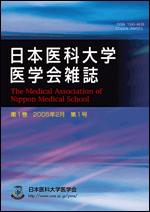19 巻, 3 号
選択された号の論文の18件中1~18を表示しています
- |<
- <
- 1
- >
- >|
特集〔遺伝子治療 update:日本医科大学の遺伝子治療研究〕
-
2023 年 19 巻 3 号 p. 198
発行日: 2023/08/31
公開日: 2023/09/16
PDF形式でダウンロード (163K) -
2023 年 19 巻 3 号 p. 199-204
発行日: 2023/08/31
公開日: 2023/09/16
PDF形式でダウンロード (349K) -
2023 年 19 巻 3 号 p. 205-210
発行日: 2023/08/31
公開日: 2023/09/16
PDF形式でダウンロード (366K) -
2023 年 19 巻 3 号 p. 211-217
発行日: 2023/08/31
公開日: 2023/09/16
PDF形式でダウンロード (359K) -
2023 年 19 巻 3 号 p. 218-223
発行日: 2023/08/31
公開日: 2023/09/16
PDF形式でダウンロード (382K) -
2023 年 19 巻 3 号 p. 224-228
発行日: 2023/08/31
公開日: 2023/09/16
PDF形式でダウンロード (932K) -
2023 年 19 巻 3 号 p. 229-234
発行日: 2023/08/31
公開日: 2023/09/16
PDF形式でダウンロード (1048K) -
2023 年 19 巻 3 号 p. 235-241
発行日: 2023/08/31
公開日: 2023/09/16
PDF形式でダウンロード (511K) -
2023 年 19 巻 3 号 p. 242-246
発行日: 2023/08/31
公開日: 2023/09/16
PDF形式でダウンロード (1120K)
橘桜だより
-
2023 年 19 巻 3 号 p. 247
発行日: 2023/08/31
公開日: 2023/09/16
PDF形式でダウンロード (262K)
グラビア
-
2023 年 19 巻 3 号 p. 252-253
発行日: 2023/08/31
公開日: 2023/09/16
PDF形式でダウンロード (1117K)
綜説
-
2023 年 19 巻 3 号 p. 254-262
発行日: 2023/08/31
公開日: 2023/09/16
PDF形式でダウンロード (1313K)
症例報告
-
2023 年 19 巻 3 号 p. 263-268
発行日: 2023/08/31
公開日: 2023/09/16
PDF形式でダウンロード (1965K)
話題
-
2023 年 19 巻 3 号 p. 269
発行日: 2023/08/31
公開日: 2023/09/16
PDF形式でダウンロード (139K)
JNMSのページ
-
2023 年 19 巻 3 号 p. 270-278
発行日: 2023/08/31
公開日: 2023/09/16
PDF形式でダウンロード (466K)
特集〔医療における AI の可能性〕第 32 回公開「シンポジウム」
-
2023 年 19 巻 3 号 p. 279-282
発行日: 2023/08/31
公開日: 2023/09/16
PDF形式でダウンロード (352K) -
2023 年 19 巻 3 号 p. 283-285
発行日: 2023/08/31
公開日: 2023/09/16
PDF形式でダウンロード (486K) -
2023 年 19 巻 3 号 p. 286-290
発行日: 2023/08/31
公開日: 2023/09/16
PDF形式でダウンロード (326K)
- |<
- <
- 1
- >
- >|
